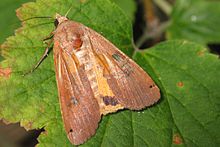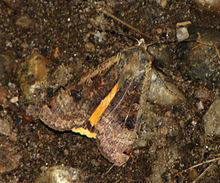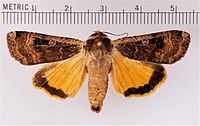- Large Yellow Underwing
-
Large Yellow Underwing 
Scientific classification Kingdom: Animalia Phylum: Arthropoda Class: Insecta Order: Lepidoptera Family: Noctuidae Genus: Noctua Species: N. pronuba Binomial name Noctua pronuba
(Linnaeus, 1758)Synonyms - Phalaena (Noctua) pronuba Linnaeus, 1758
- Noctua connuba Hübner, [1822]
- Triphaena innuba Treitschke, 1825
- Triphaena pronuba var. hoegei Herrich-Schäffer, 1861
- Agrotis pronuba var. nigra Krausse, 1912
- Rhyacia pronuba f. decolorata Turati, 1923
The Large Yellow Underwing (Noctua pronuba) is a moth, the type species for the family Noctuidae. It is an abundant species throughout Europe, one of the most common and most familiar moths of the region. In some years the species is highly migratory with large numbers appearing suddenly in marginal parts of the range.
It is also present from North Africa eastward to India. It was introduced into North America at Nova Scotia. Since then it has increased its range considerably and has been recorded for Maine in 1985, and then spread throughout the northeast from Vermont and Massachusetts (1989) to New Hampshire (1990), New York, Maryland (1992), and Connecticut (1993). It was first recorded in Pennsylvania in 1998, North Carolina (1997) and west to Colorado (1999), Wyoming (2000), California (2001) and British Columbia (2002). The latest new record is from Alaska (2005).[citation needed]
This is a quite large and heavy moth with a wingspan of 50–60 mm. The forewings are quite variable from light brown to almost black. The darker individuals often have a pale streak along the costa. The hindwings are bright orange-yellow with a black sub-terminal band. As with other Noctua species (and numerous other insects), this contrast of drab-at-rest and bright-in-flight is used to confuse potential predators. This species flies at night from July to September [1] and is attracted to light, sometimes in huge numbers. It will also visit flowers such as Buddleia, ragwort and Red Valerian.
The larva is green or brown with two rows of black dashes along the back. This is one of the notorious "cutworms", causing fatal damage at the base of virtually any herbaceous plant (some examples listed below), sometimes severing it completely. This ubiquitous species is one of the most hated of garden pests. The species overwinters as a larva and feeds on mild days throughout the winter.
- ^ The flight season refers to the British Isles. This may vary in other parts of the range.
Recorded food plants
- Allium
- Beta - Beet
- Brassica
- Calendula - Marigold
- Chrysanthemum
- Dahlia
- Daucus - Carrot
- Dianthus - Carnation
- Fragaria - Strawberry
- Freesia
- Gladiolus
- Hieracium - Hawkweed
- Lactuca - Lettuce
- Lycopersicon - Tomato
- Plantago - Plantain
- Poaceae - Grasses
- Primula
- Rheum - Rhubarb
- Solanum - Potato
- Spinacia - Spinach
- Taraxacum - Dandelion
- Viola - Sweet violet
- Vitis - Grape
References
- Chinery, Michael Collins Guide to the Insects of Britain and Western Europe 1986 (Reprinted 1991)
- Skinner, Bernard Colour Identification Guide to Moths of the British Isles 1984
External identifiers for Noctua pronuba EOL 10928856 Also found in: Wikispecies Categories:- Noctua
- Butterflies and moths of North America
- Animals described in 1758
Wikimedia Foundation. 2010.



